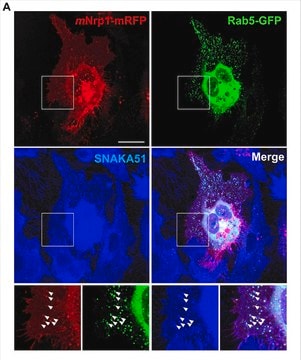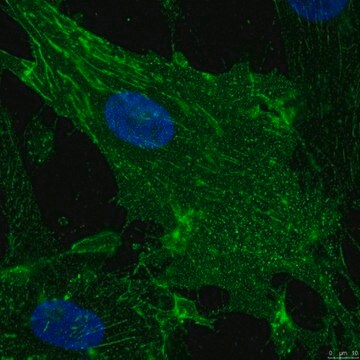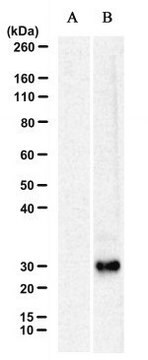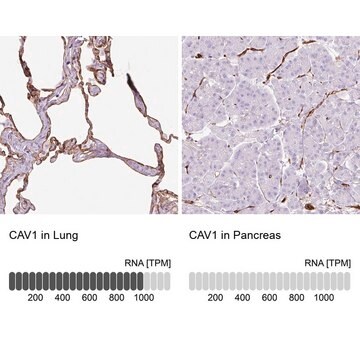MABT820
Anti-Integrin alpha 5 (CD49e) Antibody, clone mAb16
clone mAb16, from rat
Synonim(y):
CD49 antigen-like family member E, Fibronectin receptor subunit alpha, Integrin alpha-F, VLA-5, CD49e
About This Item
Polecane produkty
pochodzenie biologiczne
rat
Poziom jakości
forma przeciwciała
purified antibody
rodzaj przeciwciała
primary antibodies
klon
mAb16, monoclonal
reaktywność gatunkowa
human
metody
immunocytochemistry: suitable
immunoprecipitation (IP): suitable
inhibition assay: suitable
izotyp
IgG2aκ
numer dostępu NCBI
numer dostępu UniProt
Warunki transportu
ambient
docelowa modyfikacja potranslacyjna
unmodified
informacje o genach
human ... ITGA5(3678)
Opis ogólny
Specyficzność
Immunogen
Zastosowanie
Inhibition Analysis: A representative lot inhibited WI38 fibroblast attachment to fibronectin (Akiyama, S.K., et. al. (1989). J Cell Biol. 109(2):863-75).
Inhibition Analysis: A representative lot inhibited A375-SM cell spreading. (Humphries, J.D., et. al. (2005). J Biol Chem. 280(11):10234-43).
Immunocytochemistry Analysis: A representative lot detected Integrin alpha5 (CD49e) in Immunocytochemistry applications (Akiyama, S.K., et. al. (1989). J Cell Biol. 109(2):863-75).
Immunoprecipitation Analysis: A representative lot immunoprecipitated Integrin alpha5 (CD49e) in Immunoprecipitation applications (Akiyama, S.K., et. al. (1989). J Cell Biol. 109(2):863-75).
Cell Structure
Jakość
Immunocytochemistry Analysis: A 1:25 dilution of this antibody detected Integrin alpha5 (CD49e) in human Foreskin Fibroblast (HFF) cells.
Opis wartości docelowych
Postać fizyczna
Przechowywanie i stabilność
Handling Recommendations: Upon receipt and prior to removing the cap, centrifuge the vial and gently mix the solution. Aliquot into microcentrifuge tubes and store at -20°C. Avoid repeated freeze/thaw cycles, which may damage IgG and affect product performance.
Inne uwagi
Oświadczenie o zrzeczeniu się odpowiedzialności
Not finding the right product?
Try our Narzędzie selektora produktów.
polecane
Kod klasy składowania
12 - Non Combustible Liquids
Klasa zagrożenia wodnego (WGK)
WGK 2
Certyfikaty analizy (CoA)
Poszukaj Certyfikaty analizy (CoA), wpisując numer partii/serii produktów. Numery serii i partii można znaleźć na etykiecie produktu po słowach „seria” lub „partia”.
Masz już ten produkt?
Dokumenty związane z niedawno zakupionymi produktami zostały zamieszczone w Bibliotece dokumentów.
Nasz zespół naukowców ma doświadczenie we wszystkich obszarach badań, w tym w naukach przyrodniczych, materiałoznawstwie, syntezie chemicznej, chromatografii, analityce i wielu innych dziedzinach.
Skontaktuj się z zespołem ds. pomocy technicznej








